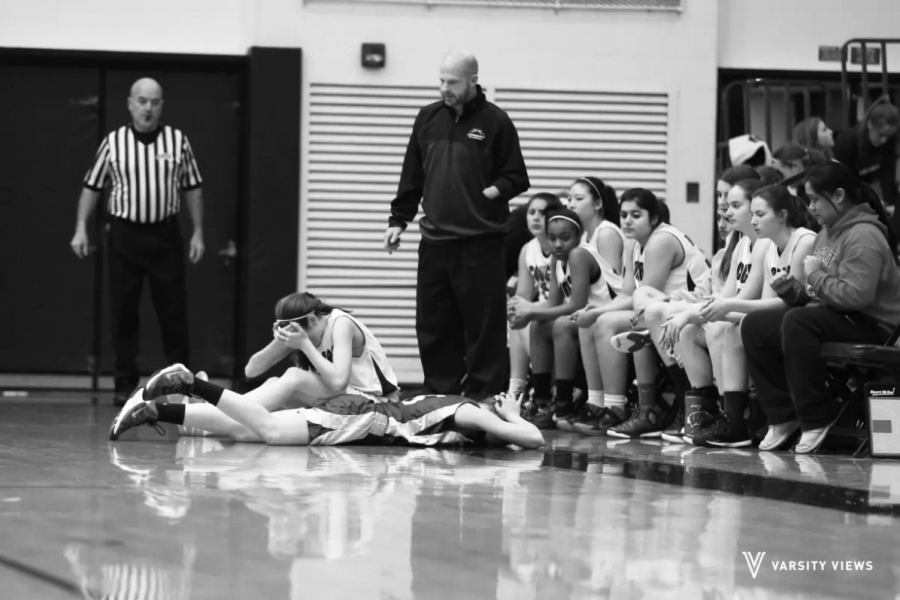State requires new concussion regulations
Varsity Views: www.varsityviews.com
CONCUSSION DISCUSSION: Lying face down on the basketball court during a game on Jan. 13, sophomore Lauren Meier struggles with a head inury, later diagnosed as a concussion. By the next school year, Illinois middle and high schools must fit concussion management to state standards, according to the Youth Sports Concussion Safety Act.
February 5, 2016
Illinois middle and high schools will be required to adjust their concussion management to state standards, by the 2016-2017 school year, as mandated by the Youth Sports Concussion Safety Act.
The act’s regulations had originally planned to be fully made official at the beginning of 2016, but the implementation was pushed back when Governor Bruce Rauner approved amendments on Nov. 20, 2015. According to Tony Catsaros, head athletic trainer, while South had a majority of the necessary components in place prior to the enactment, postponing the law probably helped other schools.
“[The push back] is great, because then all these other schools that may not have had all the […] pieces in place [now] have time,” Catsaros said.
According to the Illinois High School Association (IHSA) website, the act requires concussion policies to be compliant with all IHSA guidelines including return-to-learn and return-to-play policies. Catsaros explained that the two policies are followed in order to get a student active again after a concussion. The duration for recovery depends on each student, but he also believes the programs at South help students catch up on work in order to make the transition easier.
“[There are] great things here at GBS between the TLC, guided study opportunities and [the return to learn program],” Catsaros said. “[They’re all] well established with our guidance counselors and with our teachers as well, so the teachers all get notified if one of their students has a concussion. [Teachers] can make some accommodations [in their classes], in terms of allowing [their students to] rest from certain assignments until they are ready.”
Senior Erica Gelman got her first concussion during a soccer game when she was elbowed in the head. Unaware of her injury, Gelman was diagnosed with a concussion two days later, which took two months to heal. She went through the return-to-learn recovery program.
“I was unable to [do work because] I kept forgetting what to do as I jumped from one problem to the next,” Gelman said. “My concentration was absolutely shot. I was also unable to write [essays] and felt super off emotionally.”
The new law also orders use of IHSA-provided educational materials on head injuries, creation of a Concussion Oversight Team (COT), training for all coaches and licensed officials and development of an emergency action plan for serious injuries that could rapidly deteriorate a student’s condition, Catsaros said. He also revealed that GBS will have to face few changes as a result of the act, since GBS had already fulfilled a majority of its requirements.
“We already had [a COT], we just didn’t call it [that],” Catsaros said. “ […] Part of the law says that you should have a physician on your team when applicable and since we are able to do so here, we just had a recent discussion [about starting to work] on making sure we add a physician to our [COT] by next year.”
Another adjustment that will need to be made is the appropriate distribution of emergency action plans—written last year—as mandated by the act, according to Catsaros. They are currently hung in athletic sites in the building next to emergency exit procedures. More plans will be added to outdoor locations during the upcoming spring sports season.
“It’s just something we wanted to make sure we had [last year], so we added them to the school incident plan,” Catsaros said. “Those were then distributed to our local fire department, as well as the police department.”
The added physician, anticipated to be in place by the end of the spring, will have direct involvement with the recovering process for students. Catsaros says this will be the most noticeable change for students suffering from a concussion since the passage of the act.
“[The students will be able to see] the physician for evaluation or clearance, but [there will also be] an athletic trainer working under the direction of the physician,” Catsaros said.
Mike Noll, assistant athletic director, sees the addition of a new physician as another important factor in the recovery process for students.
“[Adding a physician] leaves very little room to get [concussion management] wrong,” Noll said. “I think it’s all about the safety and health of our athletes, and that can only be a good thing.”



